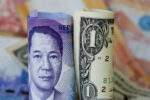The country’s foreign obligations increased by 2.6 percent in the first three months this year or by USD3.3 billion on the back of greater private sector borrowings, mostly private lenders requiring foreign financing in pursuit of their corporate goals.
This helped push the country’s external debt in relation to local output expansion or the gross domestic product (GDP) to USD 128.7 billion, a level still considered prudent, the Bangko Sentral ng Pilipinas (BSP) said.
At this level, the country’s foreign debt nudged higher to 29 percent of GDP from 28.8 percent of GDP a quarter earlier.
“Positive investor sentiment also contributed to the growth in the debt stock as investments in Philippine debt securities by non-residents rose by USD 1.2 billion. In addition, prior periods’ adjustments also increased the country’s debt level by USD 551 million. The negative USD 927 million FX revaluation of borrowings denominated in other currencies amid US dollar appreciation partially tempered the rise in the debt stock,” the BSP said.
Further boosting confidence in the level of debt are the gross international reserves (GIR) as enough to cover 3.8 times the country’s short-term debt based on obligations falling due over the next 12 months.
“The debt service ratio (DSR), which relates principal and interest payments (debt service burden) to exports of goods and receipts from services and primary income, improved to 8.9 percent from 13 percent for the same period last year due to lower scheduled debt service payments in the first quarter of 2024. The DSR and the GIR cover for ST debt are measures of the adequacy of the country’s foreign exchange (FX) resources to meet maturing obligations,” the BSP explained.
Also, the country’s foreign debts remain predominantly medium to long-term obligations or those that nature longer than one year or 86.7 percent of total.
The bulk of the obligations were extended by Japanese creditors, followed by creditors in the United Kingdom and by the Netherlands.







